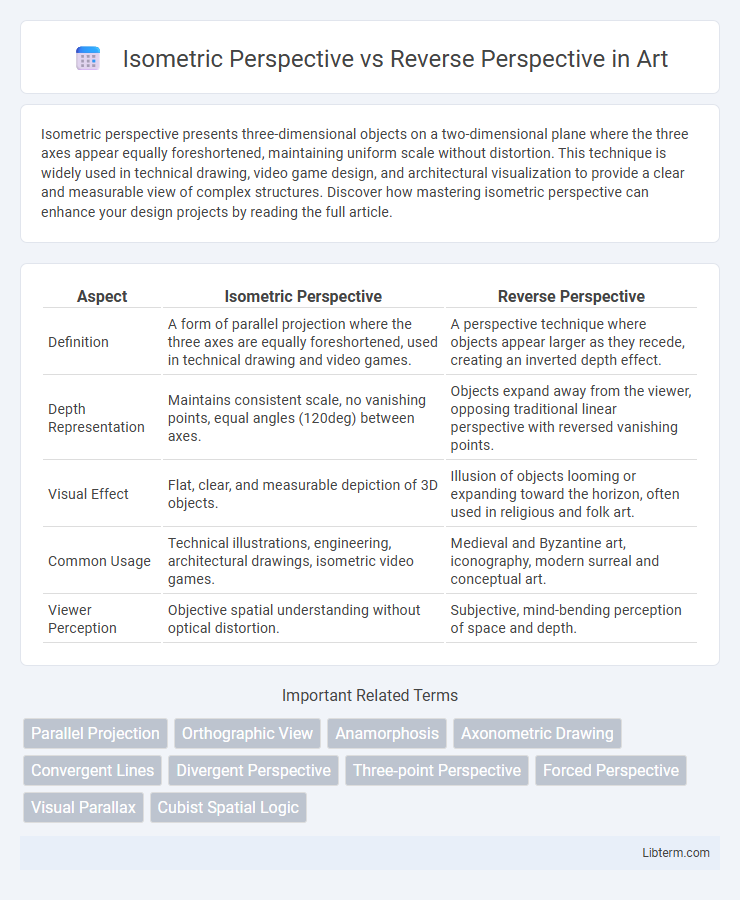Isometric perspective presents three-dimensional objects on a two-dimensional plane where the three axes appear equally foreshortened, maintaining uniform scale without distortion. This technique is widely used in technical drawing, video game design, and architectural visualization to provide a clear and measurable view of complex structures. Discover how mastering isometric perspective can enhance your design projects by reading the full article.
Table of Comparison
| Aspect | Isometric Perspective | Reverse Perspective |
|---|---|---|
| Definition | A form of parallel projection where the three axes are equally foreshortened, used in technical drawing and video games. | A perspective technique where objects appear larger as they recede, creating an inverted depth effect. |
| Depth Representation | Maintains consistent scale, no vanishing points, equal angles (120deg) between axes. | Objects expand away from the viewer, opposing traditional linear perspective with reversed vanishing points. |
| Visual Effect | Flat, clear, and measurable depiction of 3D objects. | Illusion of objects looming or expanding toward the horizon, often used in religious and folk art. |
| Common Usage | Technical illustrations, engineering, architectural drawings, isometric video games. | Medieval and Byzantine art, iconography, modern surreal and conceptual art. |
| Viewer Perception | Objective spatial understanding without optical distortion. | Subjective, mind-bending perception of space and depth. |
Introduction to Visual Perspectives
Isometric perspective presents objects without vanishing points, maintaining parallel lines to convey depth in technical illustrations and video game design. Reverse perspective, also known as inverted perspective, creates a visual effect where objects appear to project outward towards the viewer, challenging conventional depth perception. These contrasting visual perspectives influence how spatial relationships and three-dimensional forms are interpreted in art, architecture, and digital media.
Understanding Isometric Perspective
Isometric perspective is a method of visually representing three-dimensional objects in two dimensions, where the three axes appear equally foreshortened and the angles between them are 120 degrees. This technique preserves scale and proportions without distortion, making it ideal for technical drawings, video game graphics, and architectural designs. Understanding isometric perspective facilitates accurate spatial visualization and consistent measurement, unlike reverse perspective which manipulates depth cues for artistic effect.
Exploring Reverse Perspective
Reverse perspective challenges traditional visual representation by projecting objects with lines that diverge toward the viewer, creating an illusion where nearer parts appear smaller and farther parts appear larger. Unlike isometric perspective, which maintains consistent scale without convergence and is widely used in technical and architectural drawings, reverse perspective manipulates spatial depth to engage viewers in a dynamic and immersive experience. This technique is often employed in art and design to evoke psychological depth and destabilize conventional spatial understanding, making it a powerful tool for creative expression.
Key Differences Between Isometric and Reverse Perspectives
Isometric perspective uses parallel projection where all dimensions along the axes remain proportionally scaled without convergence, creating a uniform, three-dimensional representation ideal for technical drawings and video games. Reverse perspective inverts visual cues by depicting objects as expanding outward or converging towards the viewer, often producing a disorienting or surreal effect used in art and visual storytelling. The primary difference lies in spatial interpretation: isometric maintains consistent angles and scale, while reverse perspective manipulates depth perception to challenge conventional spatial relationships.
Historical Origins and Artistic Uses
Isometric perspective, rooted in 17th-century engineering drawings, employs parallel lines to create three-dimensional objects without vanishing points, facilitating clear technical and architectural illustrations. Reverse perspective, emerging from Byzantine and Russian Orthodox iconography, uses converging lines toward the viewer to evoke spiritual depth and challenge conventional spatial perception. Both techniques serve distinct artistic purposes: isometric perspective enhances precision and planning, while reverse perspective emphasizes symbolic and emotional engagement.
Applications in Modern Design and Art
Isometric perspective, characterized by equal angles and scale without convergence, is widely used in modern design for video games, technical illustrations, and architectural visualization, providing clear spatial relationships and consistent measurements. Reverse perspective, which inverts conventional depth cues by enlarging distant objects, finds niche applications in contemporary art and installation design, challenging viewers' perception and creating immersive, surreal environments. Both techniques enhance user experience by manipulating spatial interpretation, where isometric views emphasize clarity and functionality, while reverse perspective engages emotional and cognitive responses.
Visual Impact and Audience Perception
Isometric perspective creates a uniform visual impact with parallel lines, allowing viewers to perceive objects without depth distortion, fostering clarity and technical precision. Reverse perspective challenges traditional visual depth by projecting lines outward from the viewer, resulting in a dynamic, engaging effect that alters audience perception of space and dimensionality. The contrasting perspectives influence cognitive interpretation, where isometric offers stability and accuracy, while reverse perspective evokes intrigue and unconventional spatial awareness.
Advantages of Isometric Perspective
Isometric perspective offers a consistent scale where objects maintain their proportions regardless of depth, enhancing technical clarity in architectural and engineering drawings. It allows for easy measurement and comparison of dimensions directly from the illustration, streamlining design communication and reducing errors. This method also simplifies the visualization of complex structures by presenting multiple sides simultaneously without distortion.
Benefits of Reverse Perspective
Reverse perspective enhances spatial understanding by presenting objects with faces that expand toward the viewer, creating a more engaging and immersive experience compared to isometric perspective. This technique emphasizes depth and volume, allowing for clearer visualization of complex architectural structures and art compositions. Its ability to challenge conventional viewpoints fosters creative interpretation and improves cognitive engagement in visual analysis.
Choosing the Right Perspective for Your Project
Choosing the right perspective for your project involves understanding the visual impact and usability of isometric perspective versus reverse perspective. Isometric perspective offers consistent scale and clear spatial relationships, ideal for technical illustrations, games, and architecture where accurate measurements matter. Reverse perspective challenges conventional depth cues to create striking, attention-grabbing visuals useful for conceptual art and immersive installations that aim to distort perception.
Isometric Perspective Infographic

 libterm.com
libterm.com